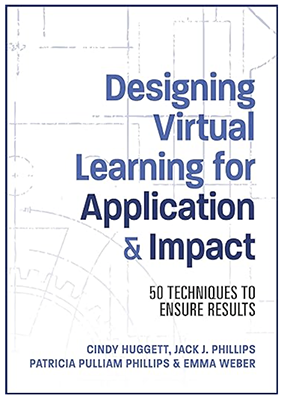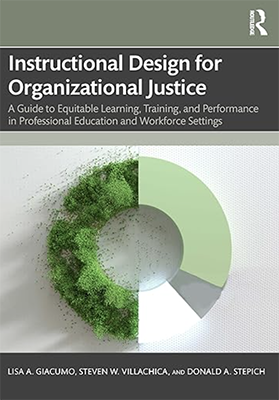Over the past year, many excellent and resourceful books have crossed my desk or Kindle. I’m rounding them up here so you can find a few to expand your horizons. The list below is in alphabetical order by title.
Each book is unique, yet as a collection, they reflect some common themes and trends in Learning and Development: a focus on empathy and emotion, adopting best practices from other fields, using data for greater impact, aligning projects with organizational goals, and developing consultative skills. The authors listed here are optimistic and forward-thinking—they believe change is possible. I hope you enjoy the books.
The Accidental Instructional Designer, 2nd Edition: Learning Design for the Digital Age by Cammy Bean

The second edition of The Accidental Instructional Designer is an important book that updates the mega-popular first edition published a decade ago. Author Cammy Bean explains what instructional designers need to know and understand now. A few topics she covers include tools and technology, working with subject matter experts, effective interactivity, storytelling, and visual design. Importantly, this updated book provides a big-picture view of where and how learning and development fit into an organization. Don’t try to transition into the field without reading this book first. Listen to my conversation with Cammy Bean about her book.
Data and Analytics for Instructional Designers by Megan Torrance

Data and Analytics for Instructional Designers demystifies how to apply data to improve learning and performance. Author Megan Torrance shows instructional designers how to design learning experiences with data collection in mind as one source of insights among many. This book provides a flexible and creative framework for understanding the diverse things you can do with data to gain new perspectives. Listen to my conversation with Megan Torrance as she walks through a real-world data scenario.
Designing Virtual Learning for Application and Impact: 50 Techniques to Ensure Results by Cindy Huggett, Jack J. Phillips, Patricia Pulliam Phillips, and Emma Weber

The techniques we use for in-person training often translate poorly to virtual training. Designing Virtual Learning for Application and Impact helps instructional designers and trainers transition to creating and facilitating virtual learning experiences. An admirable feature of this book is that Part 1 emphasizes aligning business and training goals, and Part 3 focuses on a methodology for evaluating impact and return on investment. The essential middle portion, Part 2, focuses on sound techniques for successfully designing virtual training. Since virtual learning will only increase in the future, Designing Virtual Learning is a reference many will find useful. Listen to my conversation with Cindy Huggett: Virtual Training is Much More Than a Presentation.
High-Impact Design for Online Courses: Blueprinting Quality Digital Learning in Eight Practical Steps by Bethany Simunich, Andrea Gregg, Penny Ralston-Berg

High-Impact Design for Online Courses (HIDOC) presents a streamlined instructional design framework for higher education faculty and learning designers. The authors present an approach that is both practical and supported by theory. Each comprehensive chapter is dedicated to one step of the framework and provides readers with the appropriate context and guidance. The closing chapter presents ten varied course design cases and how they were revised using the HIDOC framework. Listen to my conversation with Andrea Gregg about usability for online courses or download the transcript.
Instructional Design for Organizational Justice: A Guide to Equitable Learning, Training, and Performance in Professional Education and Workforce Settings by Lisa A. Giacumo, Steven W. Villachica, and Donald A. Stepich

This textbook adopts a unique and timely perspective on instructional design. The authors merged their iterative design process with a diversity, equity, and inclusion framework. Their goal is for leaders and practitioners to design learning interventions that are “culturally responsive, inclusive, equitable, and just.” Ideally, inclusive design methods will have a broader effect on the organizational culture. Instructional Design for Organizational Justice shows learning designers how to consider both effectiveness and equity in their interventions.
The L&D Pivot Point: Performance Improvement Consulting by Guy Wallace

The goal of The L&D Pivot Point is to help L&D professionals in managerial and analyst roles identify the root causes of performance problems that may be deeper than knowledge and skill deficits. Author Guy Wallace relies on his 40+ years of experience to present his comprehensive approach to Performance Improvement Consulting. His framework highlights the potential environmental and human factors that are often overlooked. The L&D Pivot Point is a detailed guide to a performance improvement method cultivated from real-world lessons.
Learning Experience Design Essentials by Cara North

Learning Experience Design Essentials aims to elevate learning design for new practitioners and those looking to enhance their skills. The focus is on creating impactful learning experiences that get results. Author Cara North guides readers through her LXD process, which goes deeper than ADDIE. She encourages readers to make a 30/60/90-day plan to apply the concepts and provides a plan at the end of each chapter. The book covers much of what you may need to expand your learning design process, such as managing project requests and scope, integrating UX and UI practices, designing for accessibility, creating work-based scenarios, running quality assurance, and leveraging evaluation data.
Make It Meaningful: Taking Learning Design From Instructional to Transformational by Clark Quinn

Make it Meaningful complements Clark Quinn’s previous book on learning science. Here, he focuses on engaging emotions because they play a crucial role in learning. He presents three design phases to trigger emotional engagement based on research. The first is using cognitive learning principles to create a solid framework that can link to emotional treatments. Second, he explains ways to make people care about their learning and understand its relevance. The third phase is evoking emotional engagement by delivering an experience with the right level of challenge. By the end, you will be convinced that addressing emotions is essential to learning design. Listen to my conversation with Clark Quinn about learning myths or download the transcript.
Needs Assessment on a Shoestring by Kelly L. Jones and Jody N. Lumsden

You will like the realistic perspective the authors infuse into Needs Assessment on a Shoestring. They address the issue of running a needs assessment with limited time, budget, and resources. They also know that an organization’s needs may or may not include training. The book’s first section, Build, explains a needs assessment process emphasizing strategy. The second section, Borrow, helps you identify the organizational data and expertise you need for your mission and how you might try to get it. (Not always an easy task.) The third section, Buy, focuses on estimating the time and budget for the project. This book presents a straightforward approach to conducting a needs assessment that anyone can follow.
Quality Management in Learning and Development by Hadiya Nuriddin

Quality Management in Learning and Development fills a critical gap in the L&D industry. The gap consists of a lack of knowledge and know-how for meeting each organization’s quality standards—resulting in lower-quality products and output than in comparative fields. Author Hadiya Nuriddin explains how practitioners can define quality standards for their organization, create a quality support system, and ensure everyone has the tools and support to maintain the quality guidelines. This is the big-picture view that our industry needs.
Talk to the Elephant: Designing Learning for Behavior Change by Julie Dirksen

When traditional instructional design practices didn’t work to change behavior, Julie Dirksen looked for another way. She discovered she could integrate a systems view paired with a behavioral design model into instructional design practices for a powerful effect. Talk To The Elephant will walk you through this approach. You’ll learn to analyze behaviors with the Behavior Change Wheel and COM-B model and then map your analysis to the appropriate solutions. The goal is to improve your instructional design practice by ensuring the likelihood of behavior change success. Listen to Focus on Behavioral Change in Instructional Design or download the transcript.
The Ultimate Guide to Creating Online Learning Video: A Comprehensive Handbook for Instructional Designers by Mark Lassoff

This book really is the ultimate guide to creating videos for online learning. Author Mark Lassoff provides readers with what they need for video success. He starts with foundation chapters that include the rationale for using video and the relevant learning theory and principles to follow. A foundation chapter also explains video types, tools, and distribution channels. The book’s core covers all aspects of production, from pre-production planning through the video shoot and finishing with post-production editing. The final chapters focus on accessibility for video and assessments. The unique element here is Lassoff’s instructional perspective throughout. If you want to improve your video skills for online learning, this book should be your guide.



The book sounds very interesting Megan. Feel free to add a link to the book in a Comment here. I’m not exactly sure what you mean in terms of you’d like to hear my thoughts.
Thanks,
Connie
Hi Connie, I’d be interested to hear your thoughts on a book published last year titled “The Multidisciplinary Instructional Designer” edited by Chris Gamrat and myself. We had some great design voices represented in that work.
Of course there are books, but none happened to be sent to me in the past year and that’s what I was reviewing. Michael Rodriguez has a textbook titled Developing and Validating Test Items. I interviewed him here: https://theelearningcoach.com/podcasts/39/. You don’t really hear much about criterion-referenced assessments for workplace learning.
I understand because I am the same way. And isn’t that one of the wonderful things about this career? There are so many directions to go in and so much to learn! Thanks for writing.
Connie
Yes, Will’s book is important. I was reviewing more recent books but I do highly recommend that one! Here’s my podcast episode talking about this with Will: https://theelearningcoach.com/podcasts/31/.
These are great recommendations! If I could add one more: Performance-Focused Learner Surveys by Will Thalheimer. We are piloting his approach now and already seeing improvements in our instruction (using surveys to nudge instructors, students, and stakeholders is brilliant).
Thank you, Connie, for providing these valuable resources. Although I am what some consider “seasoned” in the industry, I always want to learn more.
It isn’t ID if there isn’t assessment to create the feedback loop. Criterion-Referenced preferably. Maybe there is a book on the topic😁.
Thanks for the mention; great company to be in!